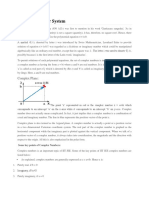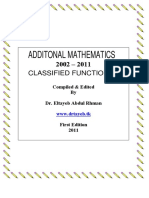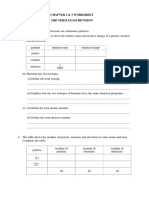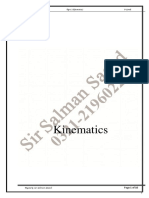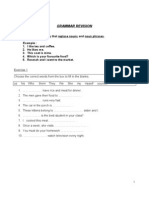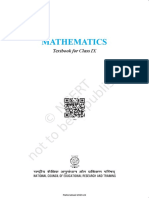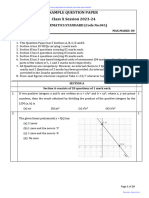Scheme of Work Mathematics Form 2
Scheme of Work Mathematics Form 2
Uploaded by
Stephanie KimiCopyright:
Available Formats
Scheme of Work Mathematics Form 2
Scheme of Work Mathematics Form 2
Uploaded by
Stephanie KimiCopyright
Available Formats
Share this document
Did you find this document useful?
Is this content inappropriate?
Copyright:
Available Formats
Scheme of Work Mathematics Form 2
Scheme of Work Mathematics Form 2
Uploaded by
Stephanie KimiCopyright:
Available Formats
Scheme Of Work Mathematics Form 2, 2011
Week/Date
1 (3/1-7/1)
Topics
1.1 Perform computations involving multiplication and division of integers to solve problems 1.2 Perform computations involving combined operations of addition, subtraction, multiplication and division of integers to solve problems 1.3 Extend the concept of integers to fractions to solve problems. 1.4 Extend the concept of integers to decimals to solve Problems 1.5 Perform computations involving directed numbers (integers, fractions and decimals) 2.1 Understand and use the concept of squares of Numbers
Learning Outcomes
Students will be able to: i. Multiply integers. ii. Solve problems involving multiplication of integers. iii. Divide integers. iv. Solve problems involving division of integers. i. Perform computations involving combined operations of addition, subtraction, multiplication and division of integers. ii. Solve problems involving combined operations of addition, subtraction, multiplication and division ofintegers including the use of brackets i. Perform addition, subtraction, multiplication or division involving two directed numbers. ii. Perform computations involving combination of two or more operations on directed numbers including the use of brackets. iii. Pose and solve problems involving directed numbers
Suggested Teaching and Learning Activities
Use concrete materials such as coloured chips and multiplication tables to demonstrate multiplication and division of integers. Complete multiplication table by recognising patterns. Solve problems related to real-life situations. e.g. ( 2) 3 + ( 4) 4 x ( 3) ( 6) Students use calculators to compare and verify answers. Solve problems related to real-life situations such as money and temperature.
Remarks
2- 3 (10/1- 21/1)
Explore addition, subtraction, multiplication and division using standard algorithm and estimation. Perform operations on integers. e.g. 2 + ( 3) x 4 Perform operations on fractions. Perform operations on decimals. e.g. 2.5 1.2 x ( 0.3) Perform operations on integers, fractions and decimals. Solve problems related to real-life situations. Recognise squares of numbers as the areas of the associated squares. Use pencil-and-paper method, mental and speed calculations to evaluate squares of numbers where appropriate.
4 (24/1-29/1)
i. State a number multiplied by itself as a number to the power of two and vice-versa. ii. Determine the squares of numbers without using calculators. iii. Estimate the squares of
numbers. iv. Determine the squares of numbers using calculators. v. List perfect squares. vi. Determine if a number is a perfect square. vii. Pose and solve problems involving squares of numbers. 2.2 Understand and use the concept of square roots of positive numbers. i. State the square root of a positive number as the number multiplied by itself equals to the given number. ii. Determine the square roots of perfect squares without using calculator. iii. Determine the square roots of numbers without using calculators. iv. Multiply two square roots. v. Estimate square roots of numbers. vi. Find the square roots of numbers using calculators. vii. Pose and solve problems involving squares and square roots.
Use estimation to check whether answers are reasonable. e.g. 27 is between 20 and 30. 272 is between 400 and 900. Explore square numbers using calculators. Explore perfect squares. Explore the concept of square roots using areas of squares. Investigate multiplications involving square roots of: a) the same number b) different numbers. Use estimation to check whether answers are reasonable. e.g. 7 is between 4 and 9 7 is between 2 and 3. Use calculators to explore the relationship between squares and square roots.
5 (31/1-4/2)
2.3 Understand and use the concept of cube of numbers.
Cuti Tahun Baru Cina
i. State a number multiplied by itself twice as a number to the power of three and vice versa. ii. Determine cubes of numbers without using calculators. iii. Estimate cubes of numbers. iv. Determine cubes of numbers using calculators. v. Pose and solve problems involving cubes of numbers. Recognise cube of a number as the volume of the associated cube. Use pencil-and-paper method, speed and mental calculations to evaluate cubes of numbers Explore estimation of cubes of numbers. e.g. 0.48 is between 0.4 and 0.5 0.483 is between 0.064 and 0.125 Explore cubes of numbers using calculator. Use calculators to explore the relationship between cubes and cube roots. Explore estimation of cube roots of numbers. e.g.
6 (7/2-11/2)
2.4 Understand and use the concept of cube roots of numbers.
i. State the cube root of a number as the number multiplied by itself twice equals to the given number. ii. Determine the cube roots of integers
without using calculators. iii. Determine the cube roots of numbers without using calculators. iv. Estimate cube roots of numbers. v. Determine cube roots of numbers using calculators. vi. Pose and solve problems involving cubes and cube roots. vii. Perform computations involving addition, subtraction, multiplication, division and mixed operations on squares, square roots, cubes and cube roots. 3.1 Understand the concept of algebraic terms in two or more unknowns. i. Identify unknowns in algebraic terms in two or more unknowns. ii. Identify algebraic terms in two or more unknowns as the product of the unknowns with a number. iii. Identify coefficients in given algebraic terms in two or more unknowns. iv. Identify like and unlike algebraic terms in two or more unknowns. v. State like terms for a given algebraic term. i. Find the product of two algebraic terms. ii. Find the quotient of two algebraic terms. iii. Perform multiplication and division involving algebraic terms.
20 is between 8 and 27. 3 20 is between 2 and 3. Limit to: a) Fractions that can be reduced such that the numerators and denominators are cubes of integers. b) Decimals that can be written in the form of cube of another decimal. Explore the relationship between cubes and cube roots using calculators.
7 (14/2-18/2)
Students identify unknowns in given algebraic terms. e.g. 3ab : a & b are unknowns. 3d 2 : d is an unknown. Use examples of everyday situations to explain algebraic terms in two or more unknowns.
3.2 Perform computations Involving multiplication and division of two or more terms.
Explore multiplication and division of algebraic terms using concrete materials or pictorial representations. e.g. Find the area of a w all covered by 10 pieces of tiles each measuring x cm by y cm. Perform multiplication and division such as: 6pq 2 x 3p 2qr Use situations to demonstrate the concept of algebraic expression. e.g.
8 (21/2-25/2)
3.3 Understand the concept of algebraic
i. Write algebraic expressions for given situations using letter symbols.
expressions.
ii. Recognise algebraic expressions in two or more unknowns. iii. Determine the number of terms in given algebraic expressions in two or more unknowns. iv. Simplify algebraic expressions by collecting like terms. v. Evaluate expressions by substituting numbers for letters. i. Multiply and divide algebraic expressions by a number. ii. Perform: a) addition b) subtraction involving two algebraic expressions. iii. Simplify algebraic expressions. i. State the relationship between two quantities by using the symbols = or .
a) Add 7 to a number: n + 7. b) A number multiplied by 2 and then 5 added: (n x 2) + 5 or 2n + 5. Investigate the difference between expressions such as 2n and n + 2; 3(c + 5) and 3c + 5; n2 and 2n; 2n2 and (2n)2 .
3.4 Perform computations involving algebraic expressions.
9 (28/2-4/3)
4.1 Understand and use the concept of equality.
4.2 Understand and use the concept of linear equations in one unknown.
i. Recognise linear algebraic terms. ii. Recognise linear algebraic expressions. iii. Determine if a given equation is: a) a linear equation b) a linear equation in one unknown. iv. Write linear equations in one unknown for given statements
Use situations to explain computations involving algebraic expressions. Investigate why 8(3x 2) = 24x 16. Add and subtract algebraic expressions by removing bracket and collecting like terms. Simplify algebraic expressions Use concrete examples to illustrate = and . Discuss cases such as: a) If a = b then b = a. e.g. 2+3 = 4+1 then 4+1 = 2+3 b) If a = b and b = c, then a =c. e.g. 4+5 = 2+7, then 2+7=3+6 then 4+5 = 3+6 Discuss why given algebraic terms and expressions are linear. Given a list of terms, students identify linear terms. e.g. 3x, xy, x2 3x is a linear term. Select linear expressions given a list of algebraic expressions. e.g. 2x + 3, x 2y, xy + 2, x2 1 2x + 3, x 2y are linear expressions. Select linear equations given a list of equations. e.g. x + 3 = 5, x 2y = 7, xy = 10 x + 3 = 5, x 2y = 7 are linear equations. x + 3 = 5 is linear equation in
10 (7/3-11/3)
4.3 Understand the concept of solutions of linear equations in one unknown.
i. Determine if a numerical value is a solution of a given linear equation in one unknown. ii. Determine the solution of a linear equation in one unknown by trial and improvement method. iii. Solve equations in the form of: a) x + a = b b) x a = b c) ax = b d) ax = b where a, b, c are integers and x is an unknown. iv. Solve equations in the form of ax + b = c, where a, b, c are integers and x is an unknown. v. Solve linear equations in one unknown. vi. Pose and solve problems involving linear equations in one unknown.
one unknown. Include examples from everyday situations. Use concrete examples to explain solutions of linear equation in one unknown. e.g. Relate x + 2 = 5 to + 2 = 5. Solve and verify linear equations in one unknown by inspection and systematic trial, using w hole numbers, with and without the use of calculators. Involve examples from everyday situations.
(14/3-19/3) 11 (21/3-25/3) 12 (28/3- 1/4)
5.2 Understand the concept of proportion to solve problems. 5.1 Understand the concept of ratio of two quantities
Cuti Pertengahan Semester 1 Ujian Serentak 1
i. Compare two quantities in the form a : b ii. Determine whether given ratios are equivalent ratios. iii. Simplify ratios to the lowest terms. iv. State ratios related to a given ratio i. State whether two pairs of quantities is a proportion. ii. Determine if a quantity is proportional to another quantity given two values of each quantity. iii. Find the value of a quantity given the ratio of the two quantities and the value of another quantity. iv. Find the value of a quantity given the ratio Use everyday examples to introduce the concept of ratio. Use concrete examples to explore: a) equivalent ratios b) related ratios. Use everyday examples to introduce the concept of proportion. Verify the method of cross multiplication and use it to find the missing terms of a proportion.
and the sum of the two quantities. v. Find the sum of two quantities given the ratio of the quantities and the difference between the quantities. vi. Pose and solve problems involving ratios and proportions. vii. Find the value of each of the three quantities given: a) the ratio and the sum of three quantities b) the ratio and the difference between two of the three quantities. viii. Find the sum of three quantities given the ratio and the difference between two of the three quantities. ix. Pose and solve problems involving ratio of three quantities.
13
(4/4- 9/4)
5.3 Understand and use the concept of ratio of three quantities to solve problems.
i. Compare three quantities in the form a : b : c. ii. Determine whether given ratios are equivalent ratios. iii. Simplify ratio of three quantities to the lowest terms. iv. State the ratio of any two quantities given ratio of three quantities. v. Find the ratio of a : b : c given the ratio of a : b and b : c. Include quantities of different units. a:b=p:q b:c=m:n when a) q = m b) q m Begin with unitary method. Simplify equivalent lowest terms value sum Difference vi. Find the value of the other quantities, given the ratio of three quantities and the value of one of the quantities. vii. Find the value of each of the three quantities given:
Use everyday examples to introduce the concept of ratio of three quantities. Use concrete examples to explore equivalent ratios.
a) the ratio and the sum of three quantities b) the ratio and the difference between two of the three quantities. viii. Find the sum of three quantities given the ratio and the difference between two of the three quantities. ix. Pose and solve problems involving ratio of three quantities. 6.1 Understand the relationship between the sides of a right angled triangle. i. Identify the hypotenuse of right-angled triangles. ii. Determine the relationship between the lengths of the sides of a right-angled triangle. iii. Find the length of the missing side of a right-angled triangle using the Pythagoras theorem. iv. Find the length of sides of geometric shapes using Pythagoras theorem. v. Solve problems using the Pythagoras theorem. i. Determine whether a triangle is a rightangled triangle. ii. Solve problems involving the converse Pythagoras theorem. Students identify the hypotenuse of right-angled triangles draw n in different orientations. Use dynamic geometry software, grid papers or geo-boards to explore and investigate the Pythagoras theorem.
14 (11/4-15/4)
6.2. Understand and use the converse of the Pythagoras theorem.
Explore and investigate the converse of the Pythagoras theorem through activities.
15 (18/4-22/4)
7.1 Perform constructions using straight edge (ruler and set square) and compass.
i. Construct a line segment of given length. ii. Construct a triangle given the length of the sides. iii. Construct: a) perpendicular bisector of a given line segment b) perpendicular to a line passing through a point on the line c) perpendicular to a line passing through a point not on the line. iv. Construct:
Relate constructions to properties of rhombus and isosceles triangle. Relate the construction to the properties of equilateral triangle. iv. Construct: a) angle of 60 and 120 b) bisector of an angle. Emphasise the use of the bisector of an angle to construct angles of 30, 45 and 15 and etc.
a) angle of 60 and 120 b) bisector of an angle. v. Construct triangles given: a) one side and two angles b) two sides and one angle. vi. Construct: a) parallel lines b) parallelogram given its sides and an angle.
Measure angles using protractors. Explore situation w hen two different triangles can be constructed.
16-17 (25/4- 6/5)
8.1 Understand and use the concept of coordinates
i. Identify the x-axis, y-axis and the origin on a Cartesian plane. ii. Plot points and state the coordinates of the points given distances from the y-axis and x-axis. iii. Plot points and state the distances of the points from the y-axis and x-axis given coordinates of the points. iv. State the coordinates of points on Cartesian plane. i. Mark the values on both axes by extending the sequence of given values on the axes. ii. State the scales used in given coordinate axes where: a) scales for axes are the same b) scales for axes are different. iii. Mark the values on both axes, with reference to the scales given. iv. State the coordinates of a given point with reference to the scales given. v. Plot points, given the coordinates, with reference to the scales given.
i. Identify the x-axis, y-axis and the origin on a Cartesian plane. ii. Plot points and state the coordinates of the points given distances from the y-axis and x-axis. iii. Plot points and state the distances of the points from the y-axis and x-axis given coordinates of the points. iv. State the coordinates of points on Cartesian plane. Use dynamic geometry software to explore and investigate the concept scales. Explore the effects of shapes of objects by using different scales. Explore positions of places on topography maps. Pose and solve problems involving coordinates of vertices of shapes such as: Name the shape formed by A(1, 5), B(2, 5), C(4, 3) and D(3, 3). Three of the four vertices of a square are (1, 1), (2, 5) and (6, 2). State the coordinates of the fourth vertex.
8.2 Understand and use the concept of scales for the coordinate axes.
vi. Pose and solve problems involving coordinates.
18-20 (9/5- 27/5)
Peperiksaan Pertengahan Tahun Cuti Semester Satu
8.3 Understand and use the concept of distance between two points on a Cartesian plane. i. Find the distance between two points with: a) common y-coordinates b) common x-coordinates. ii. Find the distance between two points using Pythagoras theorem. iii. Pose and solve problems involving distance between two points. Discuss different methods of finding distance between two points such as: a) inspection b) moving one point to the other c) computing the difference between the x-coordinates or y-coordinates. Students draw the appropriate right-angled triangle using the distance between the two points as the hypotenuse.
21-22 (13/6-24/6)
8.4 Understand and use the concept of midpoints.
i. Identify the midpoint of a straight line joining two points. ii. Find the coordinates of the midpoint of a straight line joining two points with: a) common y-coordinates b) common x-coordinates. iii. Find the coordinates of the midpoint of the line joining two points. iv. Pose and solve problems involving midpoints.
Introduce the concept of midpoints through activities such as folding, constructing, draw ing and counting. Use dynamic geometry software to explore and investigate the concept of midpoints.
9.1 Understand the
i. Describe and sketch the locus of a moving
Use everyday examples such as
23-24 (27/6-8/7)
concept of two dimensional loci.
9.2 Understand the concept of the intersection of two loci.
object. ii. Determine the locus of points that are of: a) constant distance from a fixed point b) equidistant from two fixed points c) constant distance from a straight line d) equidistant from two intersecting lines. iii. Construct the locus of a set of all points that satisfies the condition: a) the point is at a constant distance from a fixed point b) the point is at equidistant from two fixed points c) the point is at a constant distance from a straight line d) the point is at equidistant from two intersecting lines. i. Determine the intersections of two loci by drawing the loci and locating the points that satisfy the conditions of the two loci.
familiar routes and simple paths to introduce the concept of loci. Discuss the locus of a point in a given diagram. e.g. Describe a locus of a point equidistant from A and C.
Use everyday examples or games to discuss the intersection of two loci. Mark the points that satisfy the conditions: a) Equidistant from A and C. b) 3 cm from A. Introduce the concept of circle as a locus. Use dynamic geometry software to explore parts of a circle.
25 ( 11/7-15/7)
10.1 Recognise and draw parts of a circle.
i. Identify circle as a set of points equidistant from a fixed point. ii. Identify parts of a circle: a) center b) circumference c) radius d) diameter e) chord f) arc g) sector h) segment iii. Draw : a) a circle given the radius and centre b) a circle given the diameter
10.2 Understand and use the concept of circumference to solve problems.
c) a diameter passing through a specific point in a circle given the centre. d) a chord of a given length passing through a point on the circumference e) sector given the size of the angle at the centre and radius of the circle. iv. Determine the: a) center b) radius of a given circle by construction. i. Estimate the value of . ii. Derive the formula of the circumference of a circle. iii. Find the circumference of a circle, given its: a) diameter b) radius. iv. Find the: a) diameter b) radius given the circumference of a circle. v. Solve problems involving circumference of circles.
Measure diameter and circumference of circular objects. Explore the history of . Explore the value of using dynamic geometry software
26-27 (18/7-29/7)
10.3 Understand and use the concept of arc of a circle to solve problems.
i. Derive the formula of the length of an arc. ii. Find the length of arc given the angle at the centre and the radius. iii. Find the angle at the centre given the length of the arc and the radius of a circle. iv. Find the length of radius of a circle given the length of the arc and the angle at the centre. v. Solve problems involving arcs of a circle
Explore the relationship between the length of arc and angle at the centre of a circle using dynamic geometry software.
10.4 Understand and use the
i. Derive the formula of the area of a circle.
Explore the relationship between
concept of area of a circle to solve problems.
ii. Find the area of a circle given the: a) radius b) diameter. iii. Find: a) radius b) diameter given the area of a circle. iv. Find the area of a circle given the circumference and vice versa. v. Solve problems involving area of circles i. Derive the formula of the area of a sector. ii. Find the area of a sector given the radius and angle at the centre. iii. Find the angle at the centre given the radius and area of a sector. iv. Find the radius given the area of a sector and the angle at the centre. v. Solve problems involving area of sectors and area of circles. .i. Identify a transformation as a one-to-one correspondence between points in a plane. ii. Identify the object and its image in a given transformation. i. Identify a translation. ii. Determine the image of an object under a given translation. iii. Describe a translation: a) by stating the direction and distance of the movement b) in the form b a iv. Determine the properties of translation. v. Determine the coordinates of: a) the image, given the coordinates of the object b) the object, given the coordinates of the image under a translation.
the radius and the area of a circle: a) using dynamic geometry software b) through activities such as cutting the circle into equal sectors and rearranging them into rectangular form.
10.5 Understand and use the concept of area of sector of a circle to solve problems.
Explore the relationship between the area of a sector and the angle at the centre of the circle using dynamic geometry software.
28 (1/8-5/8)
11.1 Understand the concept of transformations.
Explore concepts in transformational geometry using concrete materials, drawings, geo-boards and dynamic geometry software. Explore translations given in the form b a Investigate the shapes and sizes, lengths and angles of the images and the objects.
11.2 Understand and use the concept of translations.
vi. Solve problems involving translations.
29 (8/8-12/8)
11.3 Understand and use the concept of reflections.
i. Identify a reflection. ii. Determine the image of an object under a reflection on a given line. iii. Determine the properties of reflections. iv. Determine: a) the image of an object, given the axis of reflection b) the axis of reflection, given the object and its image. using the method of construction v. Determine the coordinates of: a) the image, given the coordinates of the object b) the object, given the coordinates of the image under a reflection. vi. Describe a reflection given the object and image. vii. Solve problems involving reflections. i. Identify a rotation. ii. Determine the image of an object under a rotation given the centre, the angle and direction of rotation. iii. Determine the properties of rotations. iv. Determine: a) image of an object, given the centre, angle and direction of rotation b) the centre, angle and direction of rotation, given the object and the image. using the method of construction v. Determine the coordinates of a) the image, given the coordinates of the object; b) the object, given the coordinates of the image under a rotation.
Explore the image of an object under a reflection by drawing, using tracing paper, or paper folding. Investigate the shapes and sizes, lengths and angles of the images and objects.
11.4 Understand and use the concept of rotations.
Explore the image of an object under a rotation by drawing and using tracing paper.
vi. Describe a rotation given the object and image. vii. Solve problems involving rotations. 11.5 Understand and use the concept of isometry. i. Identify an isometry. ii. Determine whether a given transformation is an isometry. iii. Construct patterns using isometry. i. Identify if two figures are congruent. ii. Identify congruency between two figures as a property of an isometry. iii. Solve problems involving congruence. i. Determine the properties of quadrilaterals using reflections and rotations. Use tracing papers to explore isometry.
30 (15/8-19/8)
11.6 Understand and use the concept of congruence.
Explore congruency under translations, reflections and rotations.
11.7 Understand and use the properties of quadrilaterals using concept of transformations.
Explore the properties of various quadrilaterals by comparing the sides, angles and diagonals.
31 (22/8-26/8) (29/8-3/9)
12.1 Understand geometric properties of prisms, pyramids, cylinders, cones and spheres. 12.2 Understand the concept of nets.
Ujian Serentak 2 Cuti Pertengahan Semester 2
State the geometric properties of prisms, pyramids, cylinders, cones and spheres. Explore and investigate properties of geometric solids using concrete models.
32-33 (5/9-16/9)
i. Draw nets for prisms, pyramids, cylinders and cones. ii. State the types of solids given their nets. iii. Construct models of solids given their nets. i. State the surface areas of prisms, pyramids, cylinders and cones.
Explore the similarities and differences between nets of prisms, pyramids, cylinders and cones using concrete models. Explore and derive the formulae of the surface areas of prisms, pyramids, cylinders and cones.
12.3 Understand the concept of surface area.
13.1 Understand the concept of data
34-35 (19/9-30/9)
13.2 Understand the concept of frequency.
ii. Find the surface area of prisms, pyramids, cylinders and cones. iii. Find the surface area of spheres using the standard formula. iv. Find dimensions: a) length of sides b) height c) slant height d) radius e) diameter of a solid given its surface area and other relevant information. v. Solve problems involving surface areas i. Classify data according to those that can be collected by: a) counting b) measuring. ii. Collect and record data systematically. i. Determine the frequency of data. ii. Determine the data with: a) the highest frequency b) the lowest frequency c) frequency of a specific value. iii. Organise data by constructing: a) tally charts b) frequency tables. iv. Obtain information from frequency tables. i. Construct pictograms to represent data. ii. Obtain information from pictograms. iii. Solve problems involving pictograms. iv. Construct bar charts to represent data. v. Obtain information from bar charts. vi. Solve problems involving bar charts. vii. Represent data using line
Carry out activities to introduce the concept of data as a collection of information or facts. Discuss methods of collecting data such as counting, observations, measuring, using questionnaires and interview s. Use activities to introduce the concept of frequency.
13.3 Represent and interpret data in: i. pictograms ii. bar charts iii. line graphs to solve problems.
Use everyday situations to introduce pictograms, bar charts and line graphs.
graphs. viii. Obtain information from line graphs. ix. Solve problems involving line graphs
36 (3/10-7/10) 37-39 (10/10-28/10) 40-42 (31/10-18/11) (21/11-2/1)
Ulangkaji Peperiksaan Akhir Tahun
..
Cuti Akhir Tahun
You might also like
- Sasaki Descartes's Mathematical ThoughtDocument502 pagesSasaki Descartes's Mathematical ThoughtIsabel Hernández100% (1)
- Representation of Data (S1) # 1Document6 pagesRepresentation of Data (S1) # 1Aatif QaisraniNo ratings yet
- Staticschapter 3Document205 pagesStaticschapter 3rbrackins83% (29)
- Specialist Mathematics 2019 v1.2: Unit 1 Sample Assessment InstrumentDocument14 pagesSpecialist Mathematics 2019 v1.2: Unit 1 Sample Assessment InstrumentLi NguyenNo ratings yet
- Add Math WorksheetDocument3 pagesAdd Math Worksheetnehseul100% (1)
- 9702 w17 QP 13 PDFDocument20 pages9702 w17 QP 13 PDFDhito PramudyaNo ratings yet
- Uneb Uace Physics Paper 3 2018Document6 pagesUneb Uace Physics Paper 3 2018consomugasaNo ratings yet
- Vector Worksheet 10 AnsDocument13 pagesVector Worksheet 10 AnsMegan GohNo ratings yet
- IGCSE MATHS PAST PAPER 580 - 2004 - QP - 3Document16 pagesIGCSE MATHS PAST PAPER 580 - 2004 - QP - 3Hassan mahmud100% (3)
- Diffraction (Structured) QP 1Document7 pagesDiffraction (Structured) QP 1jean lamarNo ratings yet
- 5-5 Solving Polynomial EquationsDocument7 pages5-5 Solving Polynomial Equationsapi-281499569No ratings yet
- Square, Square Roots, Cubes, Cube RootsDocument2 pagesSquare, Square Roots, Cubes, Cube Rootsjavaria227204No ratings yet
- Exercises On Quadratic FunctionsDocument4 pagesExercises On Quadratic FunctionsChris Vir JavierNo ratings yet
- Cameroon General Certificate of Education Board Ordinary Level 580 Physics 2011Document21 pagesCameroon General Certificate of Education Board Ordinary Level 580 Physics 2011DimitriNo ratings yet
- Further Maths Examination 2023 Second TermDocument5 pagesFurther Maths Examination 2023 Second Termdavidaceyen2018No ratings yet
- Differentiation: 1. What Is A Derivative?Document20 pagesDifferentiation: 1. What Is A Derivative?Tha Libra FraudsterNo ratings yet
- Form 4 Physics RevisionDocument5 pagesForm 4 Physics RevisionannmarieNo ratings yet
- 2010 - O Level A MathsDocument14 pages2010 - O Level A Mathshypetuition9993No ratings yet
- Pure Physics Definitions o LevelDocument7 pagesPure Physics Definitions o LevelDesiree ChenNo ratings yet
- VECTORS and SCALARSDocument34 pagesVECTORS and SCALARSCarl BlakeNo ratings yet
- Chapter 1 Measurement 3E SP WS3 Vernier 2011Document2 pagesChapter 1 Measurement 3E SP WS3 Vernier 2011Chandini JosephNo ratings yet
- DMS MCQ'SDocument10 pagesDMS MCQ'SSumit TileNo ratings yet
- 1.4b Solving Absolute Value Equations WorksheetDocument1 page1.4b Solving Absolute Value Equations WorksheetR ZNo ratings yet
- Zero Error Weighing Machine StructureDocument4 pagesZero Error Weighing Machine StructureRaymond Cheang Chee-CheongNo ratings yet
- Binomial Expansion With Negative Fraction Jun 2014Document13 pagesBinomial Expansion With Negative Fraction Jun 2014schaNo ratings yet
- Pure Math Cape Unit 1 Parametric DifferentiationDocument8 pagesPure Math Cape Unit 1 Parametric DifferentiationHugh IngramNo ratings yet
- ComplexDocument33 pagesComplexDipin Preet SinghNo ratings yet
- Functions PDFDocument27 pagesFunctions PDFIsrafil TamimNo ratings yet
- June 2002 P1Document16 pagesJune 2002 P1api-26543952No ratings yet
- A2 Particle Physics Worksheet PDF MS - Part 2Document18 pagesA2 Particle Physics Worksheet PDF MS - Part 2TahirNo ratings yet
- Simultaneous Equations s.3 - Nabumali High SchoolDocument13 pagesSimultaneous Equations s.3 - Nabumali High SchoolnabumaliictNo ratings yet
- EDEXCEL MODEL PHYSICS ANSWERS 1995-2001 (04-Oct-10)Document265 pagesEDEXCEL MODEL PHYSICS ANSWERS 1995-2001 (04-Oct-10)Radiant ree100% (1)
- Kinematics Notes and Past PapersDocument38 pagesKinematics Notes and Past PapersSuhaan HussainNo ratings yet
- Worksheet IGCSEDocument6 pagesWorksheet IGCSEsiennaNo ratings yet
- Maths Formula BookDocument23 pagesMaths Formula BookAli Areiqat0% (1)
- Kinematics: Physics Topic 2 (Kinematics) O-LevelsDocument10 pagesKinematics: Physics Topic 2 (Kinematics) O-LevelsSalmanNo ratings yet
- IGCSE Kinematics ReviewDocument5 pagesIGCSE Kinematics ReviewtheskepticaloneNo ratings yet
- Uneb Uace Pure Maths 1997Document4 pagesUneb Uace Pure Maths 1997Gilbert MutaiNo ratings yet
- SL Prob Practice 2Document13 pagesSL Prob Practice 2Sivagami SaminathanNo ratings yet
- Surds 2017 Sec 3 Ws 2Document11 pagesSurds 2017 Sec 3 Ws 2Juthika MandalNo ratings yet
- 8 - Gravitational FieldsDocument8 pages8 - Gravitational FieldsKamran KhursheedNo ratings yet
- Extended Revision Exercises: Algebra: Worksheet 18: Curved GraphsDocument2 pagesExtended Revision Exercises: Algebra: Worksheet 18: Curved Graphsmk hatNo ratings yet
- Third Space Learning Averages From A Frequency Table GCSE WorksheetDocument14 pagesThird Space Learning Averages From A Frequency Table GCSE WorksheettrishNo ratings yet
- Physics PureDocument135 pagesPhysics PureraymondlikashiNo ratings yet
- Chapter 5 Light Teachers GuideDocument38 pagesChapter 5 Light Teachers GuideSyahrulNo ratings yet
- HEM5 Algebra PDFDocument63 pagesHEM5 Algebra PDFAmey SonawaneNo ratings yet
- C2 Integration Worksheet QuestionsDocument15 pagesC2 Integration Worksheet QuestionsMartinLukNo ratings yet
- Scheme of Work Mathematics Form 2 2013Document31 pagesScheme of Work Mathematics Form 2 2013Puteri NorhanaNo ratings yet
- Yearly Plan 2012 Mathematics Form 2Document14 pagesYearly Plan 2012 Mathematics Form 2FikriSalimNo ratings yet
- Yearly Teaching PlanDocument7 pagesYearly Teaching PlanSean GomezNo ratings yet
- Mathematics Form 2Document18 pagesMathematics Form 2Hilmi Abd GhaniNo ratings yet
- Yearly Lesson Plan Mathematics Form2 2013Document11 pagesYearly Lesson Plan Mathematics Form2 2013Norliza SapatanohNo ratings yet
- Sekolah Menengah Kebangsaan Madai WDT 178, 91209 KUNAK, SABAH. Mathematics Form 2 Yearly Lesson Plan 2012Document20 pagesSekolah Menengah Kebangsaan Madai WDT 178, 91209 KUNAK, SABAH. Mathematics Form 2 Yearly Lesson Plan 2012Nik NabihahNo ratings yet
- SMK Tanjung Adang, Gelang Patah, Johor Yearly Lesson Plan Mathematics Form Two 2009Document12 pagesSMK Tanjung Adang, Gelang Patah, Johor Yearly Lesson Plan Mathematics Form Two 2009Adibah AliasNo ratings yet
- School: SM Agama Kota Tinggi Subject: Mathematics Form: 2Document7 pagesSchool: SM Agama Kota Tinggi Subject: Mathematics Form: 2adawiyah_04No ratings yet
- Yearly Lesson Plan Mathematics Form2 2009-AdleenDocument11 pagesYearly Lesson Plan Mathematics Form2 2009-AdleenFadhlina FadilNo ratings yet
- School: SMK Dato' Sri Amar Diraja, Muar Subject: Mathematics Form: 2Document8 pagesSchool: SMK Dato' Sri Amar Diraja, Muar Subject: Mathematics Form: 2zarina binti jusohNo ratings yet
- Ranc Pengajaran Tahunan F5 MmYearlyPlan 2014Document17 pagesRanc Pengajaran Tahunan F5 MmYearlyPlan 2014riesya1206No ratings yet
- RPT Math Form2Document7 pagesRPT Math Form2Teobeng LimauNo ratings yet
- 1.funtions VleDocument2 pages1.funtions VleStephanie KimiNo ratings yet
- Math Exam Form 1Document11 pagesMath Exam Form 1Stephanie KimiNo ratings yet
- Coordinate Form 2Document31 pagesCoordinate Form 2Stephanie KimiNo ratings yet
- Rational Cloze Questions 1-8Document6 pagesRational Cloze Questions 1-8Stephanie KimiNo ratings yet
- Modul SOLAR PMR PERAK - Paper 1 (Section B - Rational Cloze)Document10 pagesModul SOLAR PMR PERAK - Paper 1 (Section B - Rational Cloze)JeyShida75% (4)
- Algebra Assignment 2Document31 pagesAlgebra Assignment 2Stephanie KimiNo ratings yet
- The Polygons of Albrecht Dürer - 1525: G.H. HughesDocument35 pagesThe Polygons of Albrecht Dürer - 1525: G.H. HughesDarkoIlinNo ratings yet
- Add Maths Pra SPM Module 2 - Sept 2016 - p2Document21 pagesAdd Maths Pra SPM Module 2 - Sept 2016 - p2bjkhaw75No ratings yet
- M Ch-20 Application of DerivativesDocument7 pagesM Ch-20 Application of DerivativesEyad AlaaNo ratings yet
- maths-class-x-sample-paper-test-04-for-board-exam-2025-answers-1Document13 pagesmaths-class-x-sample-paper-test-04-for-board-exam-2025-answers-1Alok RanjanNo ratings yet
- BW Emoji Coordinates in Four Quadrants Graphing Activity For 6th-8th GradeDocument4 pagesBW Emoji Coordinates in Four Quadrants Graphing Activity For 6th-8th GradeJeaniqueNo ratings yet
- Optimisation in The Design of Underground Mine Access: January 2004Document19 pagesOptimisation in The Design of Underground Mine Access: January 2004Camila Aguilera AcevedoNo ratings yet
- 1.2 Lesson Position-Time GraphsDocument28 pages1.2 Lesson Position-Time GraphsSaloni PatelNo ratings yet
- Introduction To Group TheoryDocument10 pagesIntroduction To Group Theorykasun madusankaNo ratings yet
- Mathematics: Textbook For Class IXDocument12 pagesMathematics: Textbook For Class IXOm BombleNo ratings yet
- Khối 2 + Khối 3 - TIMO Vòng 2Document31 pagesKhối 2 + Khối 3 - TIMO Vòng 2Nguyen Hoang PhuongNo ratings yet
- June 2014 Question Paper 21 PDFDocument24 pagesJune 2014 Question Paper 21 PDFUmnah SaifNo ratings yet
- CBSE Sample Paper 2024 Class 10 Maths Standard SQPDocument10 pagesCBSE Sample Paper 2024 Class 10 Maths Standard SQPskhushbusahniNo ratings yet
- Me 418 Part 5Document2 pagesMe 418 Part 5Angel BaldostamoNo ratings yet
- Question Bank For Test 2 - (Unit 3 and Unit 4)Document4 pagesQuestion Bank For Test 2 - (Unit 3 and Unit 4)A.R. Pradeep KumarNo ratings yet
- Math g7 m3 Topic C Lesson 22 TeacherDocument12 pagesMath g7 m3 Topic C Lesson 22 TeacherAzwa NadhiraNo ratings yet
- Volume ProblemsDocument29 pagesVolume ProblemsRaging WolfNo ratings yet
- STD: XII (Science) Maths IMP QuestionsDocument3 pagesSTD: XII (Science) Maths IMP QuestionsYash PatelNo ratings yet
- Analytic FunctionsDocument86 pagesAnalytic FunctionsGoras Milkvado100% (1)
- Manual GeoGebraDocument423 pagesManual GeoGebraDorian Gomez100% (1)
- Thiessen Polygon Method - Procedure, Numerical, and SolutionsDocument6 pagesThiessen Polygon Method - Procedure, Numerical, and SolutionssubhaNo ratings yet
- Spline Representations Computer Graphics Lecture SlidesDocument18 pagesSpline Representations Computer Graphics Lecture SlidesMd Habibur Rahman100% (1)
- CBSE Class 10 Maths Qs Paper 2017 SA 2 Set 2Document12 pagesCBSE Class 10 Maths Qs Paper 2017 SA 2 Set 2SantanuNo ratings yet
- 2nd Mid-Term AssignmentDocument2 pages2nd Mid-Term AssignmenttunjiatunwaNo ratings yet
- DifferentialEquations 03 Compatibility PDFDocument2 pagesDifferentialEquations 03 Compatibility PDFŘïśhåbh ÇhåţúŕvëđîNo ratings yet
- Calculo Upenn 2Document7 pagesCalculo Upenn 2Valeria FrNo ratings yet
- Unit-6: Curves and Fractals: Year & Branch: S.E. Computer Engineering Subject Name: Computer Graphics (210251)Document13 pagesUnit-6: Curves and Fractals: Year & Branch: S.E. Computer Engineering Subject Name: Computer Graphics (210251)BhushanNo ratings yet
- Book of Abstracts: 3th International Conference On Mathematics and Its Application (IcoMathApp) 2022.Document31 pagesBook of Abstracts: 3th International Conference On Mathematics and Its Application (IcoMathApp) 2022.Muhsang Sudadama Lieko LiedoktoNo ratings yet



























